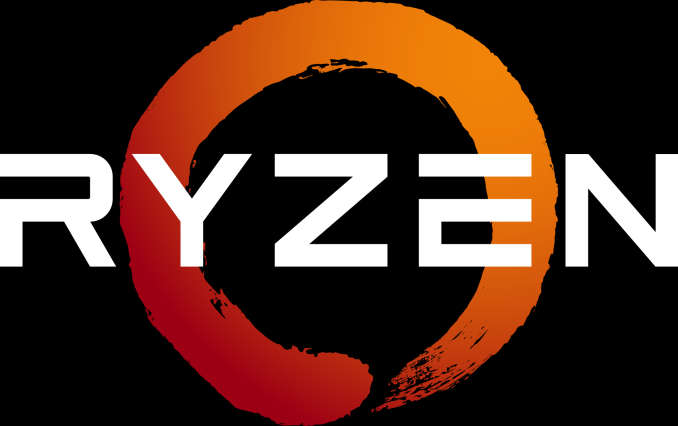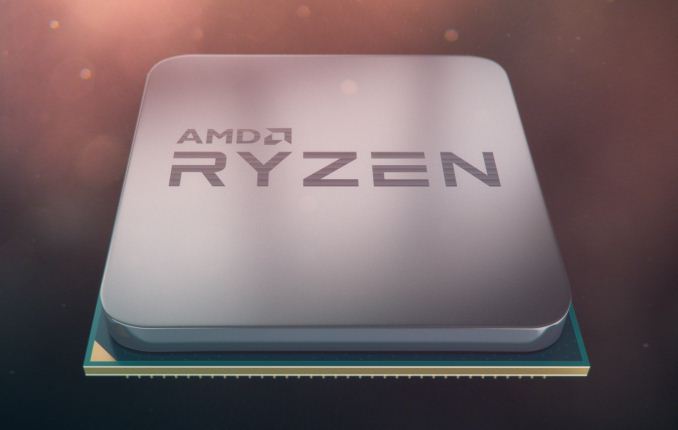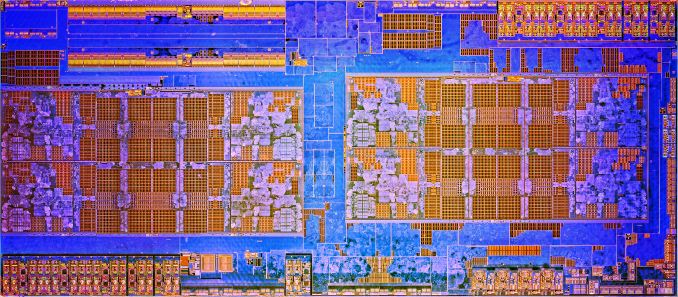AMD Launches Ryzen: 52% More IPC, Eight Cores for Under $330, Pre-order Today, On Sale March 2nd
by Ian Cutress on February 22, 2017 9:00 AM EST
The biggest x86 launch for AMD in five years is today: Ryzen is here. As always before a major launch, AMD gives a ‘Tech Day’ for relevant press and analysts, and through this event AMD’s CEO, Dr. Lisa Su lifted the lid on one of the most anticipated products in the semiconductor industry. AMD knows how to control the level of enthusiasm for its fans, and today is the end result, with processors going on pre-order from major retailers today at 1pm EST, ready for a general hard launch on March 2nd.
In a similar vein to launches of recent smartphones, AMD is doing a staggered announcement/launch with the products on their new microarchitecture. Where Samsung/Apple might give all the details for a product a few weeks before it’s available to buy, today on February 22nd marks the day where AMD is giving consumers information about Ryzen, and specifically the Ryzen 7 family of eight-core products. All the information today is from AMD, and AMD’s internal testing, and pre-orders also start from today for users ready to put down their money for a launch day part. Reviews of the CPUs, as well as when the CPUs will ship to customers, is on March 2nd. This also happens to be right in the middle of two annual shows, Game Developer Conference (GDC) and Mobile World Congress (MWC), making the time between receiving pre-launch samples and being able to provide independent verification of AMD’s performance claims relatively frantic. We’ll do our best!
The Ryzen Family
With a new processor launch, naming the parts and positioning them within the market is critical. So with Ryzen, the processor stack will be split into three based on performance and price: Ryzen 7 at the high end, Ryzen 5 in the middle, and Ryzen 3 for more price-conscious consumers. Both Ryzen 5 and Ryzen 3 are set to be launched later, and Ryzen 7 is the first portion of the family to be released.
Ryzen 7 will have three CPUs to start, all having eight cores and supporting simultaneous multi-threading:
- Ryzen 7 1800X: 8C/16T, 3.6 GHz base, 4.0 GHz turbo, 95W, $499
- Ryzen 7 1700X: 8C/16T, 3.4 GHz base, 3.8 GHz turbo, 95W, $399
- Ryzen 7 1700: 8C/16T, 3.0 GHz base, 3.7 GHz turbo, $329
Ryzen 7 1800X will be the high-end part, featuring a base clock of 3.6 GHz and a turbo of 4.0 GHz, within a TDP of 95W, and for $499. Next to this is Ryzen 7 1700X, launching at $399, with a base/turbo of 3.4/3.8 GHz. The final part for the launch is the Ryzen 7 1700, providing eight cores and sixteen threads for $329 at 3.0/3.7 GHz frequencies.
Processors will initially be available for pre-order from 185 retailers and OEMs worldwide, either as individual parts or pre-built systems.
What, not 40% IPC? 52% IPC??
Enthusiasts and analysts use the term IPC, or ‘Instructions Per Clock’, as a measure of how much the underlying microarchitecture improves from generation to generation. Two decades ago, a good design on a smaller node could net a healthy double-digit gain, whereas in recent years 5-10% gain has become the norm. When AMD initially announced that the new Zen microarchitecture they were developing was aiming for a 40% IPC gain, despite the low IPC they were starting from, users remained skeptical. AMD rehired Jim Keller to work alongside long-term AMD architect Mike Clark and produce a team with several goals in mind: high-performance x86, simultaneous multithreading, and a product to be relevant in the computing, PC, server and mobile space again. So despite this, 40% IPC always seemed a somewhat lofty goal, because Bulldozer was so underwhelming, and despite this low starting point. For the Ryzen launch today, AMD is stating that the final result of that goal is a 52% gain in IPC.
This is something we will need to test in due course!
The Ryzen Silicon, and the Future
AMD pointed out that the new 8-core silicon design runs 4.8 billion transistors and features 200m of wiring. Through previous announcements we’ve examined parts of the microarchitecture including cache sizes, threading, front-end/back-end design, and so on.
AMD Zen Microarchiture Part 2: Extracting Instruction-Level Parallelism
AMD Gives More Zen Details: Ryzen, 3.4 GHz+, NVMe, Neural Net Prediction, & 25 MHz Boost Steps
AMD’s CEO was keen to point out that this is a from-scratch design for AMD, using the knowledge gained from features developed for previous products but ultimately under the hood it looks like ‘a typical x86 high-performance core’, with AMD-specific features and tweaks. We were told that AMD’s roadmap extends into the multi-year range, so while the focus for 2017 will be on this family of products, back at HQ the next two generations are in various stages of development.
BENCHMARKS PLEASE
So despite the 82+ motherboards going to be available, 19 initial PC system builders moving into 200+ through the first half of 2017, the big question on everyone’s lips is how exactly does it perform?
Well, AMD gave us the following numbers:
AMD's benchmarks showed that the top Ryzen 7 1800X, compared to the 8-core Intel Core i7-6900K, both at out-of-the-box frequencies, gives an identical score on the single threaded test and a +9% in the multi-threaded test. AMD put this down to the way their multi-threading works over the Intel design. Also, the fact that the 1800X is half of the price of the i7-6900K.
In a similar vein, again with the Cinebench 15 multi-threaded test, the Ryzen 7 1700X scores over and above the Core i7-6800K (its price competition) and higher than the Core i7-6900K which costs 2.5 times as much.
We’ll tell you what our benchmarks say, with official retail processors. But you will have to wait until March 2nd. Sorry.





















386 Comments
View All Comments
Lolimaster - Wednesday, February 22, 2017 - link
Intel was always dependent on getting node shrinks fast with the power of money with no so much optimization. FFW to today and no matter the money Intel can't access 10nm on time. Their designs are heavily based on Core Arch, there's no much to squeeze.Lolimaster - Wednesday, February 22, 2017 - link
Core is basically a revamped Pentium III.Michael Bay - Wednesday, February 22, 2017 - link
Intel past SB is _all_ about optimization. Since opponent is a perpetual noshow, literally all they have shown for years were various design gains in power consumption.Now, I understand times are hard and AMD is not paying much for such low-grade shilling, but even you must have some modicum of self-respect, right?
dcbronco - Wednesday, February 22, 2017 - link
I think the best way to judge what Ryzen's potential is outside of retail CPU benchmarks right now is to watch Intel's reaction. Intel has dropped almost every CPU but Core, following AMD with Zen. Intel has announced an additional product refinement at 14nm after early Ryzen leaks. They are going tick, toc, toc, toc. That may be because of issues with 10nm, but Intel seems to react to every AMD move. We never saw that with the Cat cores. Intel is afraid. And even if they have a better process, with AMD potentially skipping 10nm and potentially getting 7nm out two years before Intel, AMD will have an advantage for those two years. If it takes Intel two to three years to catch up on value, we could see Intel in a hole for four or five years. If they have been getting by with incentives and payoffs to keep AMD suppressed, those obligations may start to bleed them with price cuts they will have to make. I believe Intel is afraid because they know they are in trouble. IBM used to be Chipzilla. Companies get complacent and it eventually gets their lunch eaten.andrewaggb - Wednesday, February 22, 2017 - link
exactly. they look really good right now. but we need real benchmarks and there is so much that could go wrong (like nasty processor errata) that I don't think business critical servers should use them right away. If they are stable and reliable they'll shake up the virtual machines/ec2/azure market for sure but they'll need to prove themselves a bit. They aren't doing anything intel isn't or can't and they aren't giving new performance that intel isn't or can't. That gives intel some time.Haawser - Wednesday, February 22, 2017 - link
You mean apart from ~the same performance for half the price ? Seems you forgot that bit. Intel can't do that because the E-series are actually the highest clocking Xeons they have. Much faster than their equivalent 8/10 core server parts. Which means they probably only get a handful from each wafer that can clock that high. They can't just turn on some magic tap to make more of them. That's probably one of the reasons they're so expensive in the first place.Jsizzle83 - Thursday, February 23, 2017 - link
Right now, I think it is too early to really say "~the same performance for half the price" because AMD is not actually comparing apples to apples when they make that comparison.The best value in terms of price/performance is in the lower$$ value segment (Celeron/Pentium/Corei3)... After that value drops at a fairly linear rate as price increases to corei5 .... corei7... AMD is comparing a mid-$300 CPU to an enthusiast $1000 CPU when they "CLAIM" roughly the same performance for half-the-price. To me, this is just bad logic (and good marketing). What AMD is really going to compete against is the Corei7-7700K. Their "X" series CPUs automatically overclock, so to get a real apples-to-apples comparison, one would have to determine the maximum achieved frequency of the AMD overclock, attempt to match the same overclock (manually) on the Intel 7700K, and then compare benchmarks and real-world performance (games) in a series of different tests to get an idea of performance.
Right now, I am very skeptical (but hopeful) that AMD will offer equal or better value than Intel at a number of price points. But don't take this the wrong way, but let's wait for the "REAL" tests and benchmarks and not get taken by this "faulty logic" in the marketing war. Right now, that's all this is: marketing.
Cooe - Sunday, February 28, 2021 - link
This entire post assumes all anyone EVER does with their PC is play video games... An 8-core workstation class monster was NEVER intended as a direct i7-7700K competitor, and ALWAYS had the also 8c/16t Broadwell-E as its target. Only an idiot buys an 8-core CPU JUST TO GAME. And the "X" CPU's never automatically overclocked...Manch - Wednesday, February 22, 2017 - link
Intel doesn't need to drop its prices that fast. They can more than afford to take a wait and see approach. Also remember Intel has a lot of brand cache. Some people just wont buy AMD. For them, Intel is a trusted brand and has earned their loyalty. Just like Apple which has a lot of sheep err.. brand loyalty and some people will not shy away no mater how good the competition is. I have no such loyalty when it comes to tech, and Im willing to take a chance on AMD's new processor and pre-order before all the benchies are released. From leaked benchmarks, the price/performance beats Intel hands down. In pure competition, the ZEN appears to stand on its own. Of course not too long from now we will have confirmation that will tell the whole story. Then of course consumer uptake will indicate to Intel what their next move should be. Also remember, Intel has known that ZEN was incoming for a long while. Well before we were privy to it. They're in the business to make money and stay on top. I don't doubt for one min theyre holding back. How much though, and how much TTM is the question. Either way, great for us consumers.Lolimaster - Wednesday, February 22, 2017 - link
We are on another time, all the pc master race, gaming, esports will switch to AMD, sheep will follow.